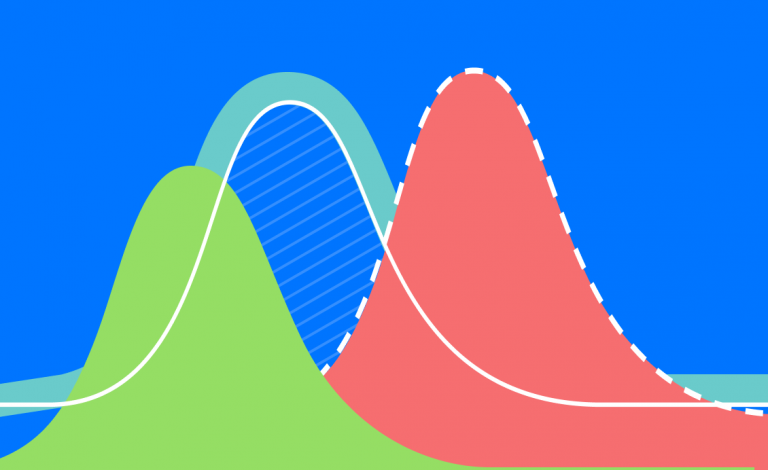The problem with traditional methods of attribution, A/B testing, and lead scoring is that they’re not always the best for businesses with long sales cycles or limited data. It can be unrealistic to wait for multiple conversions before changing your ad campaign or challenging to collect enough data to inform your attribution models.
However, these traditional methods are what most advertisers are familiar with because they’re usually effective for understanding customers and optimizing paid ad campaigns.
The good news is that there are better methods of optimizing your digital ad campaigns and boosting conversions without shifting your business model. You can better understand your prospects’ behavior and next steps through machine learning predictive models
How do advertisers measure digital ad effectiveness traditionally?
Understanding how online ads perform has always been essential to the success of advertising campaigns. These three platform-related approaches are part of the conventional advertiser’s toolkit.
1. Attribution
Attribution is how we assess the ROI (return on investment) or value of the channels that connect businesses to prospects. It’s how a customer comes to know your business and makes a purchase.
Attribution sounds simple when you think about what made the customer purchase from you. But customers rarely go straight to a website and make a purchase –– especially if your business has a long sales cycle like insurance or B2B SaaS.
Marketers usually choose between four types of attribution.
i. First or last-touch attribution
Single source attribution models allocate all the credit to one touchpoint –– either the first or last touchpoint.
First-touch attribution allocates all the credit to the first touchpoint the prospect engaged with. For example, an ebook download. Although it’s simple to analyze, first-touch attribution doesn’t acknowledge any customer interactions after the first touch. This means that any interactions with other channels following the first touch aren’t given importance.
Last-touch attribution gives credit to the prospect’s final interaction before making a purchase. For example, signing up for a free demo or reviewing a brochure. But it doesn’t credit previous interactions like website visits, social media interactions, or calls with the sales team. This means you miss out on the importance of the channels leading up to purchase.
ii. Linear attribution
Linear attribution is a multi-touch attribution model that divides credit across every touchpoint in a customer’s journey. It recognizes every channel a business uses and provides a balanced look at the whole marketing and sales strategy rather than just one touchpoint.
However, the downside is that it doesn’t show the different impacts of each channel. Businesses will find it challenging to identify the most or least successful channel.
iii. Data-driven attribution
Data-driven attribution assigns credit for purchases according to how people interact with your ad campaigns and other marketing channels.
One major advantage is that it analyzes all the interactions that led to each conversion. This gives you a more holistic view of what converted visitors, unlike single-touch attribution. Knowing the full data story will help you improve your marketing and sales strategy since you can analyze each touchpoint.
However, accurate results depend on having complete data. Google needs 15,000 clicks and 600 Floodlight conversions within the last 30 days to successfully generate a data-driven attribution model.
That’s great if you’re an eCommerce retailer with a short sales cycle. But it’s probably impossible for businesses with long sales cycles like real estate agencies.
2. A/B testing
A/B testing forms a key part of optimizing paid ad campaigns. Your current A/B testing routine probably follows similar steps each time.
When you A/B test, you likely create ads, allow the campaign to warm up, wait for a set number of conversions (perhaps 50), evaluate the results, and decide which ad performed better. You then continue to use the best-performing ad in your campaign, eliminating those that didn’t work out.
This process works well for industries with short sales cycles, for example, an online grocery store. But for businesses with longer sales cycles, this method of A/B testing can take too long to yield definite ad performance results. If you’re selling property, it’s hard to wait until you’ve made 50 sales before A/B testing your ads!
3. Lead scoring
Lead scoring helps your sales representatives prioritize and organize their leads. Traditionally, lead scoring runs on two types of data:
- Firmographic – What we know about the prospect at the time of filling in the contact form
- Product or CRM data – How the prospect behaved after the registration. Did they answer the SDR’s (sales development representative) phone calls? Did they engage with the product?
This kind of lead scoring improves the sales team’s effectiveness.
But the predictions from both these data collection methods are too basic –– they don’t reflect the real buying intent of an individual.

How does predictive machine learning boost your ad’s effectiveness?
When traditional attribution, A/B testing and lead scoring are enhanced with predictive machine learning, the results are nothing short of turbocharged ad effectiveness.
Predictive post-click attribution
Predictive post-click attribution gives long-sales cycle businesses what they’re missing from other attribution models –– timely, accurate, and reliable info for data-driven decisions.
Machine learning models analyze visitor behavior from each session and make accurate predictions about their next steps. Once the model is set up, results and scores are available in real-time. There’s also less need for having complete data –– it impacts the results far less than in data-driven attribution models.
Forecasts present expected revenue for the next four weeks, too, so you’ll know when to expect busy and quieter periods of the year. Using predictive attribution, you can make your marketing experiments up to 30x more affordable –– that way, you’ll get the most ROI on your campaigns.
Predictive conversions
Businesses with long sales cycles will find predictive conversions more effective. These make the whole A/B testing process 30-100 times faster. Instead of waiting on actual conversions that could take weeks or months to take place, you can make data-driven decisions about the effectiveness of ad campaigns more quickly.
Predictive marketing relies on data provided by website analytics and customer behavior. When visitors land on your website, they receive a monetary score according to their behavior on your site. For example, we can calculate how much revenue a click on specific touchpoints will bring the business.
Some touchpoints are more valuable than others –– a click on a demo page might bring you 1000 USD, while an ebook download might be worth 500 USD.
Analyzing visitor behavior will help you decide which paid ad to run. You won’t need to wait for 50 or more conversions. Instead, you’ll have accurate predictive data to inform your upcoming paid ad campaigns.
Predictive lead scoring
Technographic data does a better job of drilling down on potential buying behavior than its traditional counterparts, firmographic and product/CRM data.
Instead of estimating how prospects will behave as a result of their interactions with your business pre or post-registration, we score the lead’s behavior according to their interactions with your site or ads.
Based on how they clicked around on different pages and took certain actions, it’s easier to determine whether they’re a red hot lead or someone just casually browsing. Every visitor is assigned a predicted purchase value.
Understanding and analyzing the behavior of actual leads helps sales teams prioritize their leads. Predictive lead scoring can also help marketing teams determine who to target their ads to.

Are there any drawbacks?
Predictive attribution, A/B testing, and lead scoring will help you identify your business’s most valuable prospects. But like anything else, there are always some drawbacks to consider before deciding whether it’s right for your business.
Like any machine learning model, it takes time for predictive models to be trained. Currently, it takes around three months to train machine learning algorithms during a preliminary process.
But the upside is that once your model is set up, it scores visitors within two hours of their interaction. On the other hand, data-driven attribution models take seven days to appear within attribution reports in Google Analytics.
So although there’s a longer preliminary setting up process for predictive scoring models, the shape scores visitors rapidly once it’s in place.
You might also be concerned about the accuracy of machine learning. Can you trust these machine learning models to make accurate predictions about potential leads and purchasing behavior?
Accurately predict customer purchasing behavior with Tomi.ai
There’s nothing wrong with using traditional A/B testing, lead scoring, and attribution methods. They help you understand your customers and make strategic data-driven decisions about your paid ad campaigns. But they’re not always the best choice for businesses with longer sales cycles or those with limited data — predictive models are.
For example, real estate agencies, B2B SaaS, banking businesses, etc., where a customer’s LTV (lifetime value) typically matures, will benefit the most from predictive modeling.
Using predictive machine learning models can get better insights into customer behavior and their likely purchasing habits. You’ll boost your ROI on marketing campaigns and help your sales team prioritize leads.
The result? More conversions and less ad spend!
Ready to see how Tomi.ai can help you convert more prospects? Contact us today.



